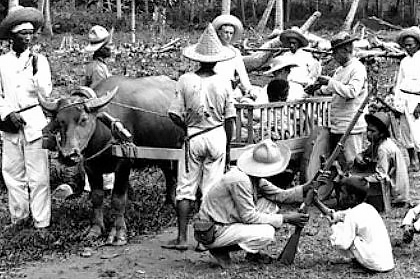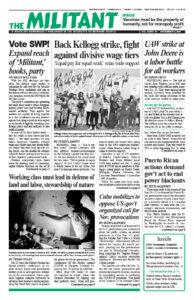Blacks in America’s Wars — The Shift in Attitudes from the Revolutionary War to Vietnam by Robert W. Mullen is one of Pathfinder’s Books of the Month for November. The excerpt below reveals a little known side of the 1898 Spanish-American War as newly emergent U.S. imperialism fought for a colonial empire from Puerto Rico to the Philippines. In both Cuba and the Philippines Washington fought revolutionary movements that had rebelled for independence from Spain, imposing a protectorate in Cuba and seizing the Philippines as a colony. Many Blacks in the U.S. backed Filipino independence, and Black U.S. soldiers sent to the Philippines openly sympathized with the resistance fighters. Copyright © 1973. Reprinted by permission of Pathfinder Press.

BY ROBERT W. MULLEN
When the Spanish-American War began, the total strength of the regular army was only 28,000 men. Among these were the four Black regiments that had been incorporated into the regular army after the Civil War and that had been very active in the Indian wars on the Western frontier. These regiments were to play a conspicuous role in American operations in both Cuba and the Philippines. …
Afro-American troops were involved in the war against Spain from the beginning. There were at least thirty Blacks on the battleship Maine when it blew up [in Cuba], of whom twenty-two were killed.
In the ensuing jingoist campaign for war with Spain, Blacks, too, shared the whipped up indignation and anger over the loss of life. In addition, the official propaganda about fighting a war to free our “little brown brothers,” the Cubans, Puerto Ricans, and Filipinos suffering under the yoke of the despotic Spanish, struck a responsive chord among Afro-Americans.
Initial Black support for the Spanish-American War was also intensified by the fact that this was the first war since Blacks had gained their freedom in the Civil War, and it took place at a time when the racial oppression against them had been intensifying for several decades. For that reason, many Blacks saw participation in the war against Spain as an ideal chance to prove their right to citizenship and equality. …
When U.S. forces ended Spanish resistance in Cuba and Puerto Rico, they turned their attention towards the Philippine Islands. But in contrast to the campaigns in the Caribbean, there was widespread public opposition in the United States to involvement in the Philippines. …
In the Philippines, an independence movement led by Emilio Aguinaldo had already been fighting the Spanish. Between 1899 and 1902, 70,000 U.S. troops were sent to the Philippines to put down his movement, which had turned against the United States when the Americans showed their opposition to Philippine independence.
For three years, the United States Army engaged in a bloody war against the Filipino guerrillas, a war which in many ways paralleled counterinsurgency methods later employed in Vietnam. Among the 70,000 U.S. troops were the four regular army Black units.
Within the Black population of the United States as a whole, there was considerable opposition to intervention in the Philippines. Most Black newspapers and leaders publicly supported the idea of Filipino independence and felt that the United States was wrong to begin to develop a colonial empire of nonwhite subjects. They could not help but feel that this could only have a deleterious effect on the relations between whites and Blacks in the United States itself. Even such normally cautious Black figures as Booker T. Washington felt they had to speak out for Filipino independence.
The Black troops themselves were placed in an extremely pointed dilemma by the U.S. actions in the Philippines. Most displayed considerable identification with the nonwhite Filipinos, an identification that was heightened by the fact that white soldiers generally referred to both Black troops and Filipinos as “niggers.” But most also felt that a good military showing by Black troops in the Philippines would enhance the cause of all Blacks in the United States and tried to reconcile these conflicting sentiments.
Opposition to the war by Blacks became so loud that by 1899 the War Department questioned whether it would be wise to send any Black troops at all to the islands. One War Department official doubted that such troops “if brought face to face with their colored Filipino cousins could be made to fire on them.”
The question was finally resolved in favor of sending Black troops, and all four regular army regiments saw action in the war. As the Americanization of the islands progressed, and the color bars against Blacks and Filipinos also progressed, Black troops increasingly felt that they were being used in an unjust war, that they were in part responsible for the racism against Filipinos that they could see spreading with American control.
Although most Black soldiers swallowed their misgivings, with the hope that their actions would reflect favorably on Blacks in America, this was not a universal reaction. The desertion rate among the Black troops was very high. According to Stephen Bonsal, desertions from Negro regiments was very different from white desertions. While whites generally deserted after quarrels with officers, or because of opposition to discipline or laziness, Blacks deserted “for the purpose of joining the insurgents.”
The Filipino guerrillas actively encouraged Blacks to desert. They regularly addressed posters to “The Colored American Soldier” in which they described the lynching and discrimination against Blacks in the United States and encouraged the Black troops not to be the instrument of their white masters’ ambitions to oppress another “people of color.” Blacks who deserted to the Filipino side were welcomed with open arms and often given positions of major responsibility.
Of all the Black deserters, the most famous was David Fagan of the Twenty-fourth Infantry. Fagan accepted a commission with Aguinaldo’s forces and for two years wreaked havoc on the Americans.

